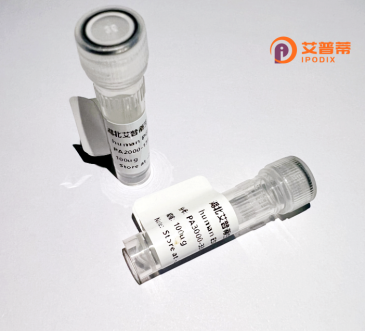
| 纯度 | >90%SDS-PAGE. |
| 种属 | Human |
| 靶点 | PLEKHG2 |
| Uniprot No | Q9H7P9 |
| 内毒素 | < 0.01EU/μg |
| 表达宿主 | E.coli |
| 表达区间 | 1-896 aa |
| 活性数据 | MFPQNAKPGFKHAGSEGELYPPESQPPVSGSAPPEDLEDAGPPTLDPSGTSITEEILELLNQRGLRDPGPSTHDIPKFPGDSQVPGDSETLTFQALPSRDSSEEEEEEEEGLEMDERGPSPLHVLEGLESSIAAEMPSIPCLTKIPDVPNLPEIPSHCEIPEGSRLPSLSDISDVFEMPCLPAIPSVPNTPSLSSTPTLSCDSWLQGPLQEPAEAPATRRELFSGSNPGKLGEPPSGGKAGPEEDEEGVSFTDFQPQDVTQHQGFPDELAFRSCSEIRSAWQALEQGQLARPGFPEPLLILEDSDLGGDSGSGKAGAPSSERTASRVRELARLYSERIQQMQRAETRASANAPRRRPRVLAQPQPSPCLPQEQAEPGLLPAFGHVLVCELAFPLTCAQESVPLGPAVWVQAAIPLSKQGGSPDGQGLHVSNLPKQDLPGIHVSAATLLPEQGGSRHVQAPAATPLPKQEGPLHLQVPALTTFSDQGHPEIQVPATTPLPEHKSHMVIPAPSTAFCPEQGHCADIHVPTTPALPKEICSDFTVSVTTPVPKQEGHLDSESPTNIPLTKQGGSRDVQGPDPVCSQPIQPLSWHGSSLDPQGPGDTLPPLPCHLPDLQIPGTSPLPAHGSHLDHRIPANAPLSLSQELPDTQVPATTPLPLPQVLTDIWVQALPTSPKQGSLPDIQGPAAAPPLPEPSLTDTQVQKLTPSLEQKSLIDAHVPAATPLPERGGSLDIQGLSPTPVQTTMVLSKPGGSLASHVARLESSDLTPPHSPPPSSRQLLGPNAAALSRYLAASYISQSLARRQGPGGGAPAASRGSWSSAPTSRASSPPPQPQPPPPAARRLSYATTVNIHVGGGGRLRPAKAQVRLNHPALLASTQESMGLHRAQGAPDAPFHM |
| 分子量 | 120.6 kDa |
| 蛋白标签 | GST-tag at N-terminal |
| 缓冲液 | PBS, pH7.4, containing 0.01% SKL, 1mM DTT, 5% Trehalose and Proclin300. |
| 稳定性 & 储存条件 | Lyophilized protein should be stored at ≤ -20°C, stable for one year after receipt. Reconstituted protein solution can be stored at 2-8°C for 2-7 days. Aliquots of reconstituted samples are stable at ≤ -20°C for 3 months. |
| 复溶 | Always centrifuge tubes before opening.Do not mix by vortex or pipetting. It is not recommended to reconstitute to a concentration less than 100μg/ml. Dissolve the lyophilized protein in distilled water. Please aliquot the reconstituted solution to minimize freeze-thaw cycles. |
以下为3篇关于重组人PLEKHG2蛋白的参考文献摘要概览:
1. **文献名称**:*PLEKHG2 regulates actin dynamics and cell migration through RhoGEF-mediated activation of Rac1*
**作者**:Luo W, et al.
**摘要**:本研究阐明PLEKHG2通过Rho鸟嘌呤核苷酸交换因子(RhoGEF)结构域激活Rac1信号通路,调控肌动蛋白重排和细胞迁移,为肿瘤转移机制提供了新见解。
2. **文献名称**:*Crystal structure of the Dbl homology domain of human PLEKHG2*
**作者**:Zhang Y, et al.
**摘要**:首次解析PLEKHG2蛋白的Dbl同源结构域晶体结构,揭示其与Rho GTPases(如Cdc42)的相互作用机制,为靶向药物设计奠定结构基础。
3. **文献名称**:*PLEKHG2 promotes TLR4-induced NF-κB activation by interacting with TRAF6*
**作者**:Chen X, et al.
**摘要**:发现重组表达的PLEKHG2通过与TRAF6结合,增强Toll样受体4(TLR4)介导的NF-κB炎症信号传导,提示其在免疫反应中的调节作用。
---
**说明**:文献中“重组”可能隐含在蛋白表达方法中(如E.coli/哺乳动物系统表达)。若需更针对性研究,建议结合具体方向筛选。
Pleckstrin homology and RhoGEF domain-containing protein G2 (PLEKHG2), also known as CLG or CLIONE, is a member of the Dbl family of Rho guanine nucleotide exchange factors (RhoGEFs). It primarily activates Rho-family GTPases, particularly Cdc42. through its RhoGEF domain, which catalyzes the exchange of GDP for GTP to regulate downstream signaling pathways. The protein contains multiple functional domains, including an N-terminal pleckstrin homology (PH) domain, a DEP (Dishevelled, Egl-10. Pleckstrin) domain, and a C-terminal RhoGEF domain. These domains facilitate membrane association, protein-protein interactions, and activation of GTPases, enabling PLEKHG2 to act as a critical mediator of cytoskeletal reorganization, cell polarity, and migration.
PLEKHG2 is ubiquitously expressed, with higher levels in the brain, immune cells, and endothelial cells. Studies suggest its involvement in neuronal development, angiogenesis, and immune responses through Cdc42-dependent signaling. Notably, dysregulation of PLEKHG2 has been linked to pathological conditions, including cancer metastasis (e.g., glioblastoma, hepatocellular carcinoma) and neurological disorders. For instance, overexpression enhances invasive cell behavior by modulating matrix metalloproteinases and actin dynamics, while mutations impair synaptic functions.
Recombinant human PLEKHG2 protein, generated via heterologous expression systems (e.g., mammalian or bacterial cells), serves as a vital tool for studying its biochemical interactions, GTPase activation mechanisms, and therapeutic targeting. Current research focuses on elucidating its role in stress responses, inflammation, and tissue remodeling, though its full regulatory network remains incompletely understood.
×